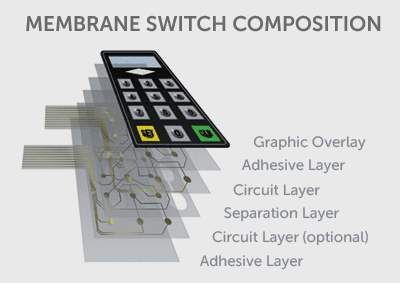A Comprehensive Guide to Membrane Switch Design and Manufacturing
Comprehending Membrane Layer Changes: The Trick to Reputable and sturdy Controls
Membrane switches over represent a crucial element of modern-day user interface style, blending performance with durability in numerous applications. These functional components not only assist in individual interaction however are likewise crafted to hold up against the roughness of demanding environments, from clinical gadgets to commercial machinery. Recognizing their building, operation, and the myriad advantages they supply is crucial for engineers and designers alike. As we explore the intricacies of membrane layer buttons, it becomes clear that their function in enhancing control systems is both profound and complex, questioning regarding how best to utilize their capacities in future technologies.
What Are Membrane Layer Switches?
Membrane layer buttons are an innovative remedy in the realm of interface innovation, incorporating capability and style effortlessly. These tools act as an interface in between customers and electronic systems, integrating a number of elements right into a small layout. Normally built from versatile, slim layers of materials, membrane layer switches are developed to reply to touch, allowing individuals to engage with machinery and digital tools efficiently.
The primary elements of a membrane switch include a printed circuit layer, graphic overlay, and a spacer layer that protects against unexpected activation. The visuals overlay can be tailored to mirror brand identity or individual choices, improving aesthetic appeals while making sure use. Membrane layer buttons are typically made use of in numerous applications, including clinical gadgets, consumer electronic devices, and commercial equipment, owing to their toughness and resistance to environmental variables such as moisture and dust.
Among the essential advantages of membrane buttons is their capacity to hold up against damage, making them ideal for high-traffic settings. In addition, they are lightweight and call for minimal space, permitting ingenious designs in item advancement. Overall, membrane layer changes represent a efficient and useful option for contemporary digital interfaces, weding technology with user-centric style concepts.

Exactly How Membrane Layer Changes Work
The procedure of membrane switches rest on a straightforward yet efficient device that converts customer input into digital signals. These switches contain multiple layers, generally including a visuals overlay, a spacer layer, and a circuit layer. When an individual presses the switch, the leading layer warps, allowing a conductive component in the circuit layer to reach a corresponding conductive pad on the bottom of the graphic overlay. This call closes the circuit and sends an electronic signal to the tool, showing that the switch has actually been activated.
The layout of membrane layer switches can vary, however they usually integrate domes or tactile components to provide responses to the user, improving the total experience. The products made use of in membrane buttons, such as polyester or polycarbonate, contribute to their sturdiness and resistance to ecological elements, consisting of dampness and dust. Moreover, the published circuits are generally this link encapsulated, which secures them from deterioration in time.

Benefits of Membrane Layer Switches
Among the key advantages of membrane buttons is their flexibility in style, enabling them to be personalized to meet particular customer demands and visual demands. This versatility reaches various industries, where different shapes, dimensions, and colors can be used to boost individual communication and aesthetic charm.
Furthermore, membrane switches are recognized for their longevity. Constructed from durable products, they are immune to dirt, moisture, and physical wear, which considerably prolongs their lifespan contrasted to standard mechanical switches. This longevity makes them specifically appropriate for high-traffic environments and applications requiring discover this info here long life.

Moreover, membrane layer switches provide a structured profile, bring about a thinner layout that can be integrated into various tools without including mass. This feature not just enhances the aesthetic appeal however additionally contributes to a more ergonomic product design.

Applications of Membrane Switches
User-friendly and functional, membrane buttons locate applications throughout a variety of industries, including medical gadgets, consumer electronic devices, and commercial devices. In the medical area, these buttons are indispensable to devices such as analysis equipment, person surveillance systems, and infusion pumps, where dependability and simplicity of cleansing are important. Their capability to maintain and withstand harsh atmospheres functionality makes them suitable for such applications.
In customer electronics, membrane buttons are made use of in items like microwaves, washing equipments, and remotes - membrane switch. Their streamlined style permits for instinctive customer interfaces, enhancing the total individual experience while supplying longevity and resistance to deterioration
Commercial equipment additionally takes advantage of membrane layer look at this web-site buttons, specifically in control panels for machinery and automation systems. These switches supply defense versus dirt and wetness, making certain regular efficiency in challenging environments. Their adjustable functions permit makers to tailor them to particular operational requirements, enhancing efficiency and functionality.
Choosing the Right Membrane Switch Over
When choosing a membrane layer switch, it is necessary to consider various elements that affect efficiency and viability for details applications. The main factors to consider consist of ecological conditions, responsive feedback, sturdiness, and design requirements.
First, assess the operating setting; buttons subjected to dampness, chemicals, or extreme temperature levels require particular products to guarantee longevity and performance. Next off, assess the demand for responsive responses. Depending upon individual interaction, some applications might take advantage of a tactile feedback to verify activation, while others might like a non-tactile style for visual factors.
Sturdiness is an additional important variable; membrane buttons must be made to endure frequent use, effects, and abrasion. Guarantee the picked switch can withstand the expected lifecycle, particularly in high-usage circumstances.
Verdict
To conclude, membrane switches work as essential elements in the style of dependable and durable control systems throughout numerous sectors. Their compact layout, combined with robust construction and personalized attributes, improves customer communication while guaranteeing longevity popular environments. The flexibility of membrane layer switches permits customized remedies that fulfill certain functional demands, reinforcing their importance in modern-day technology. membrane switch. As markets remain to advance, the significance of incorporating reliable membrane layer switch solutions can not be overstated.
Membrane switches stand for an important facet of contemporary interface design, mixing functionality with strength in various applications.Membrane layer switches are an innovative solution in the realm of individual interface technology, integrating capability and layout effortlessly. Commonly created from adaptable, thin layers of materials, membrane layer switches are made to respond to touch, making it possible for users to engage with equipment and digital gadgets effectively.
The style of membrane layer switches can vary, yet they often incorporate domes or tactile elements to provide responses to the individual, enhancing the general experience.In conclusion, membrane layer changes offer as necessary parts in the design of dependable and long lasting control systems throughout different industries.